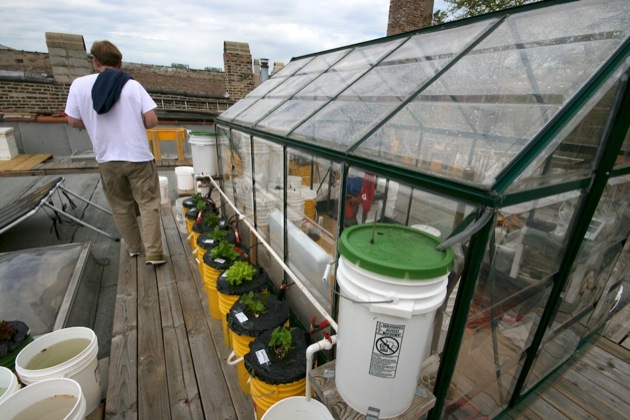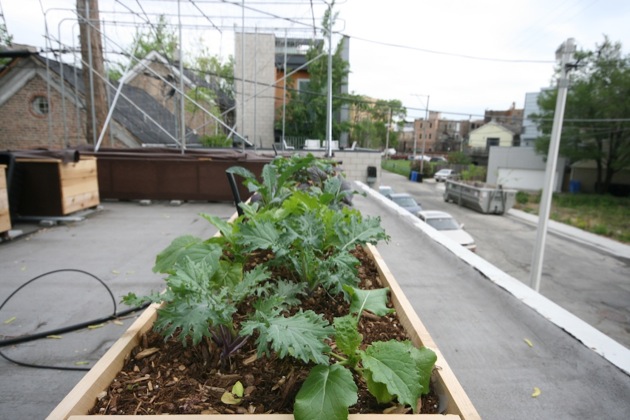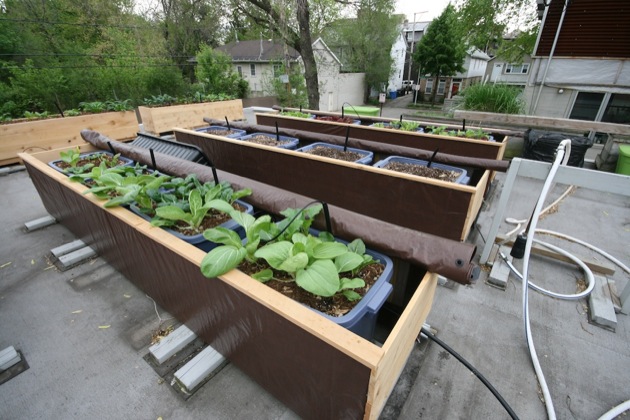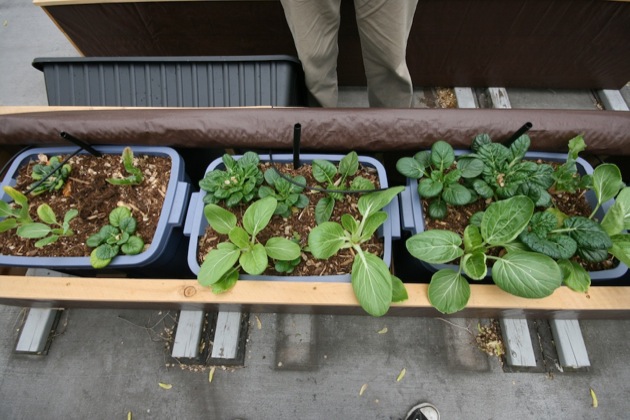A Rooftop Grows in Chicago
The SIP method of urban gardening
I've long been drawn to the idea of urban farming. When I lived in Brooklyn, I had two plots in two community gardens , in addition to three massive tomato plants on the back deck. Planting seeds and growing vegetables was an unlikely pleasure. For me it was connected to good eating: I loved to cook and eat the freshest vegetables I could find. Getting to the source is something we often explore on The Paupered Chef--from seeking out how to make a dish from scratch, to visiting wholesale fish markets in the Bronx . Growing vegetables is no different.
The clash of growing food within the concrete of a city is a beautiful dissonance. For me, it makes that tomato or bean all the more rare and delicious. Give me a garden wedged in a corner of public land near a busy avenue over idyllic rural fields any day; the urban pastoral is far more interesting.
All that aside, though, I've never been an especially talented gardener, and I don't necessarily enjoy the day-to-day chore of watering plants, weeding, etc. My favorite parts are planting and harvesting.
My Chicago apartment has no outdoor space at all, so this spring I've planned to make do with some herbs in window boxes. But I recently met some very cool local Chicagoans who are doing some amazing things on their roofs. They blog under the heading " Green Roof Growers " and use a straightforward system to grow basically foolproof vegetables.
The technique is called SIP, which stands for Sub-Irrigated Planter , a technology sold to consumers by a company called EarthBox . It is perfect for people (like me) who don't really know how to garden. You can't over- or under-water your plants. You can do it in a couple buckets from your local deli. It's cheap to set up. And if the stories are to believed, the result is a bounty of delicious vegetables.
What is SIP?
SIP stands for Sub Irrigated Planter, the technology used in Earth Boxes. Rather than watering from above like most plants, SIP growers use a water reservoir underneath the growing medium, which is then "wicked up" through a column of growing medium as the plants need it. The only thing to worry about is that the reservoir is full; the plants will "sip" as much water as they need, whenever they need it.
The EarthBox website has a nice diagram that explains the whole thing.
Advantages to SIP Growing
Watering becomes foolproof
While it's fun to plant things and obviously it's fun to harvest the vegetables, I've never heard anyone talk about the joys of watering plants. It is the part of gardening that becomes a chore and a hassle, especially if you're planting in a community garden any distance away from your home. I never quite knew how much or how often I was supposed to be watering my vegetables. With a SIP, it doesn't matter. Because the plants use just as much water as is necessary, and it is stored in the closed reservoir, problems like evaporation are kept to a minimum, so you get better yield with less water. When they're thirsty, they drink.
Less worry about weight
This applies mostly to people on rooftops, where weight can become a crucial aspect of growing. Traditional raised beds full of soil and vegetables can weigh far more than a roof is designed to handle. Most of the time when a rooftop garden is installed, all kinds of support and bracing is also necessary to make sure the roof doesn't cave in.
According to the Earthbox website, a filled earthbox (2 cubic feet of soil) is about 80 pounds. As long as the roof (or balcony) is designed to allow an adult human to walk around, weight is no longer a problem.
Ability to garden anywhere
One of the local SIP gardeners I met up with, named Heidi, also has a ground-level bed in her backyard where she grows a small crop in addition to her roof. She has a few greens growing there now and it's doing pretty well. But she also pointed out the annoyances of growing at ground level: namely, weeds and bugs. Many of her leafs had little holes in them.
Up high on a roof, where the bugs don't live, the plants were smooth and pristine.
How to Build a DIY SIP Planter
One of the gardeners I've met with, Bruce, has let me kick around his place a little bit, learning about the technology and helping along the way. In return, he's been kind enough to let me use a few of the containers to grow vegetables of my own. As the growing season goes on, I'll be checking in with how the plants are doing and what I'm growing. I'd like to explore in more detail some of the methods he's pioneered and give a tour of his and other rooftop gardens in the area.
If you'd like to build your own SIP, Green Roof Growers has all the details. Bruce has experimented with all kinds of containers and watering systems to build the perfect solution for his roof, from custom-built wooden planters to Rubbermaid tubs (see above). But I'm also drawn to the simplicity of building a container from two 5-gallon food safe buckets, which is the way many SIP gardeners start. Hundreds of buckets like these are sent to delis and restaurants around the city of Chicago every day as containers for pickles. You can easily pick them up for free or almost nothing if you ask around. The picture at the top of this post shows a number of these yellow buckets lined up, already growing food.
Everything you need to build that kind of container is explained over on the Green Roof Growers blog , so for full instructions I'll direct you there.
Happy gardening!
Food, Agriculture, Brooklyn, Chicago, Chicago, Chicago, EarthBox, food, gardener, Gardening, Gardening, Gardening, Green roof, Human Interest, Land management, Landscape, Raised bed gardening, Recreation, Roof garden, Rooftop Gardening, SIP, Sub-Irrigated Planter, Technology, Tomatoes, Urban agriculture, Watering can, Gardening





Comments:
Blog Comments powered by Disqus.